light Acura RL 2000 3.5 Owner's Guide
[x] Cancel search | Manufacturer: ACURA, Model Year: 2000, Model line: RL, Model: Acura RL 2000Pages: 330, PDF Size: 4.53 MB
Page 67 of 330
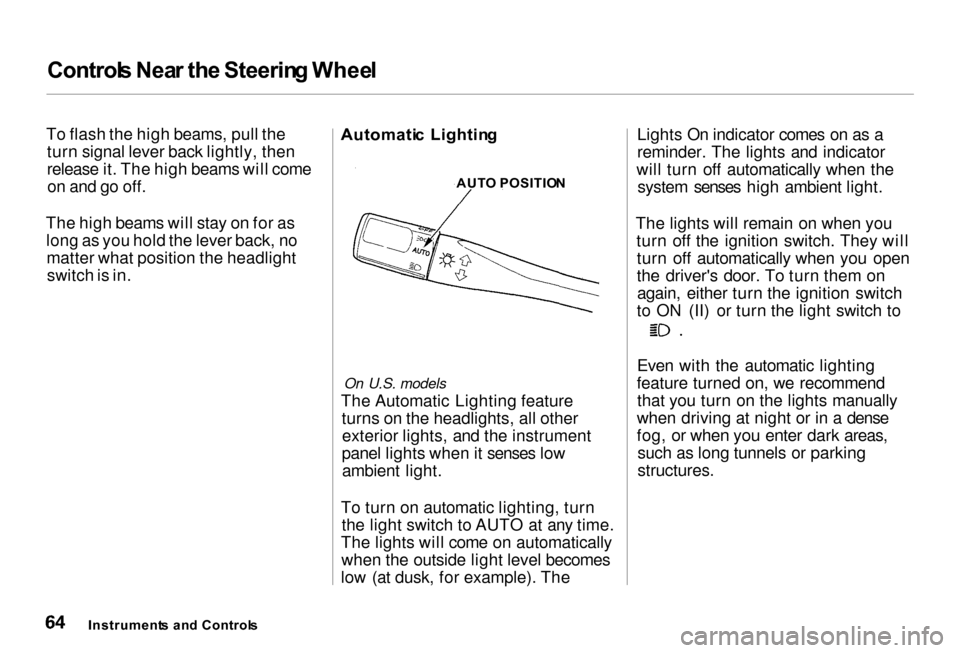
Control
s Nea r th e Steerin g Whee l
To flash the high beams, pull the turn signal lever back lightly, then
release it. The high beams will comeon and go off.
The high beams will stay on for as long as you hold the lever back, nomatter what position the headlightswitch is in. Automati
c Lightin g
On U.S. models
The Automatic Lighting feature turns on the headlights, all otherexterior lights, and the instrument
panel lights when it senses low ambient light.
To turn on automatic lighting, turn the light switch to AUTO at any time.
The lights will come on automatically when the outside light level becomes
low (at dusk, for example). The Lights On indicator comes on as a
reminder. The lights and indicator
will turn off automatically when the system senses high ambient light.
The lights will remain on when you turn off the ignition switch. They willturn off automatically when you open
the driver's door. To turn them onagain, either turn the ignition switch
to ON (II) or turn the light switch to Even with the automatic lighting
feature turned on, we recommend that you turn on the lights manually
when driving at night or in a dense
fog, or when you enter dark areas, such as long tunnels or parking
structures.
Instrument s an d Control s AUT
O POSITIO N
Page 68 of 330
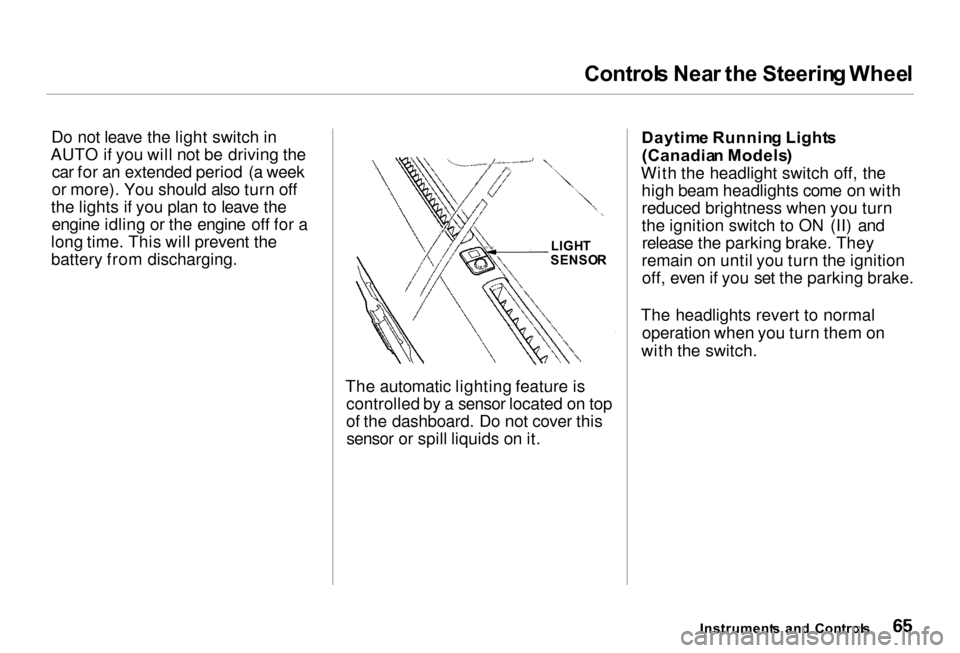
Control
s Nea r th e Steerin g Whee l
Do not leave the light switch in
AUTO if you will not be driving the car for an extended period (a week
or more). You should also turn off
the lights if you plan to leave the engine idling or the engine off for a
long time. This will prevent the
battery from discharging.
The automatic lighting feature iscontrolled by a sensor located on top
of the dashboard. Do not cover thissensor or spill liquids on it. Daytim
e Runnin g Light s
(Canadia n Models )
With the headlight switch off, the high beam headlights come on with
reduced brightness when you turn
the ignition switch to ON (II) andrelease the parking brake. They
remain on until you turn the ignition off, even if you set the parking brake.
The headlights revert to normal operation when you turn them on
with the switch.
Instrument s an d Control s
LIGH
T
SENSO R
Page 69 of 330
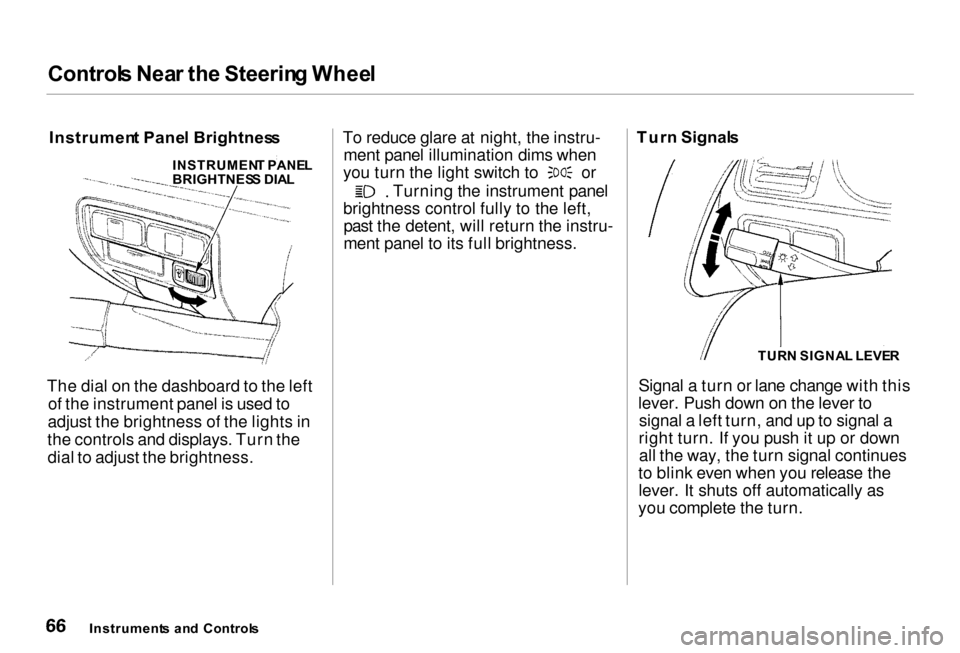
Control
s Nea r th e Steerin g Whee l
Instrumen t Pane l Brightnes s
The dial on the dashboard to the left of the instrument panel is used to
adjust the brightness of the lights in
the controls and displays. Turn the dial to adjust the brightness. To reduce glare at night, the instru-
ment panel illumination dims when you turn the light switch to or
Turning the instrument panel
brightness control fully to the left, past the detent, will return the instru-
ment panel to its full brightness. Tur
n Signal s
Signal a turn or lane change with this
lever. Push down on the lever to signal a left turn, and up to signal a
right turn. If you push it up or down all the way, the turn signal continues
to blink even when you release the lever. It shuts off automatically as
you complete the turn.
Instrument s an d Control s TUR
N SIGNA L LEVE R
INSTRUMEN
T PANE L
BRIGHTNES S DIA L
Page 70 of 330
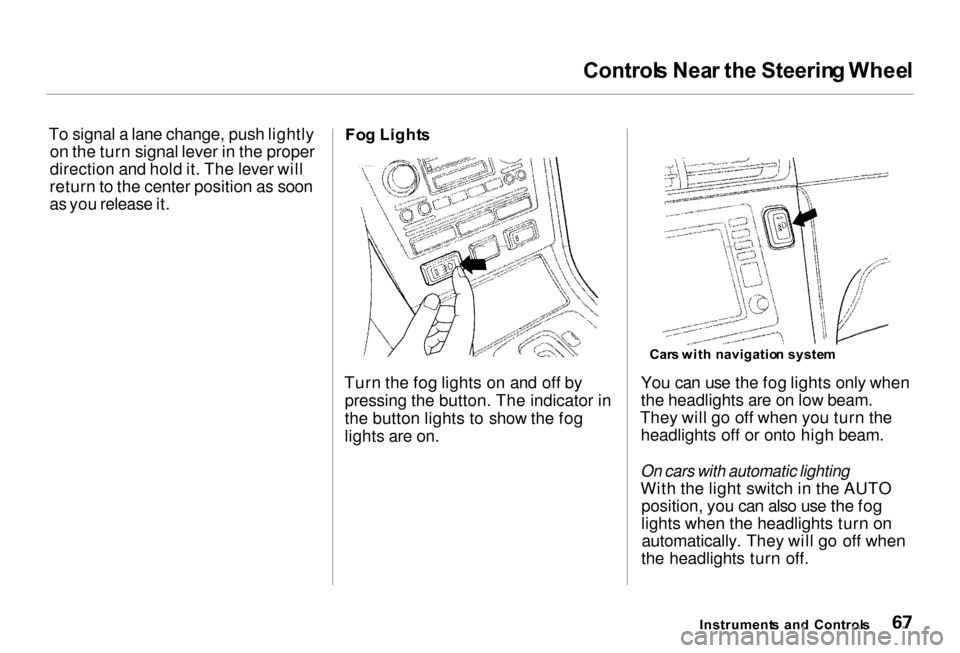
Control
s Nea r th e Steerin g Whee l
To signal a lane change, push lightly on the turn signal lever in the proper
direction and hold it. The lever will
return to the center position as soon
as you release it.
Fo
g Light s
Turn the fog lights on and off by pressing the button. The indicator in
the button lights to show the fog
lights are on. You can use the fog lights only when
the headlights are on low beam.
They will go off when you turn the headlights off or onto high beam.
On cars with automatic lighting
With the light switch in the AUTO position, you can also use the fog
lights when the headlights turn onautomatically. They will go off when
the headlights turn off.
Instrument s an d Control s
Car
s wit h navigatio n syste m
Page 71 of 330

Control
s Nea r th e Steerin g Whee l
Windshiel d Wiper s
The right lever controls the wind- shield wipers and washers. The
rotary switch at the end of the lever
has three positions: INT: intermittent
: low speed
: high speed
In intermittent, the wipers operate
every few seconds. The sweep
interval will change slightly with
speed; getting shorter as you drive
faster. In low speed and high speed, the wipers run continuously. You can vary how often the wipers
sweep the windshield by turning the
INT TIME ring next to the rotary
switch.
If you turn the INT TIME ring to the shortest delay, the wipers will
change from intermittent to low speed operation when vehicle speed
exceeds 12 mph (20 km/h).
Instrument s an d Control s
Page 72 of 330
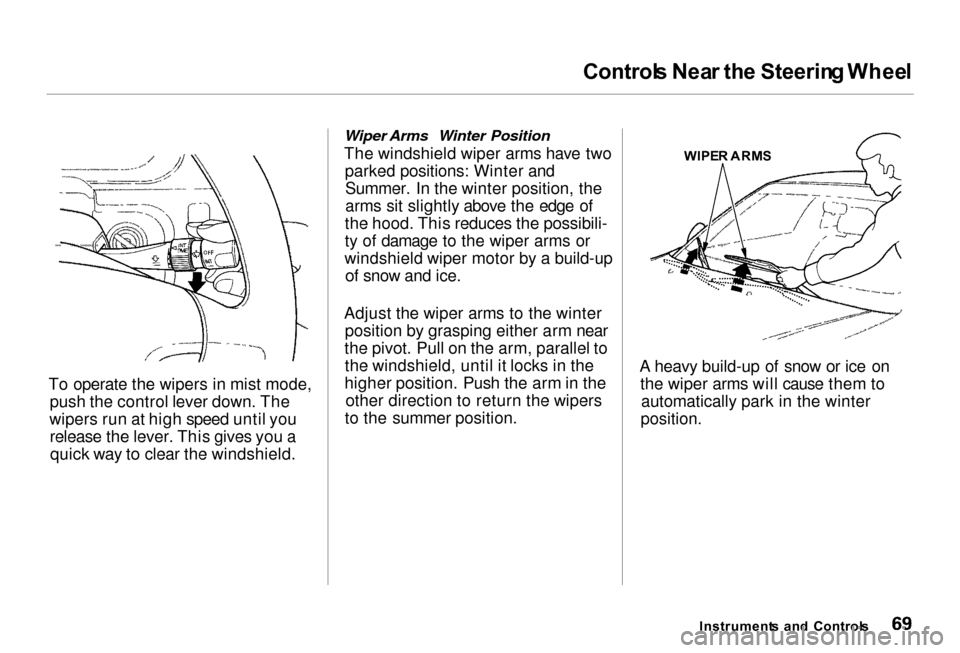
Control
s Nea r th e Steerin g Whee l
To operate the wipers in mist mode, push the control lever down. The
wipers run at high speed until you release the lever. This gives you aquick way to clear the windshield.
Wiper Arms Winter Position
The windshield wiper arms have two
parked positions: Winter andSummer. In the winter position, the
arms sit slightly above the edge of
the hood. This reduces the possibili-
ty of damage to the wiper arms or
windshield wiper motor by a build-up of snow and ice.
Adjust the wiper arms to the winter position by grasping either arm near
the pivot. Pull on the arm, parallel to the windshield, until it locks in the
higher position. Push the arm in the other direction to return the wipers
to the summer position. A heavy build-up of snow or ice on
the wiper arms will cause them toautomatically park in the winter
position.
Instrument s an d Control s
WIPE
R ARM S
Page 73 of 330
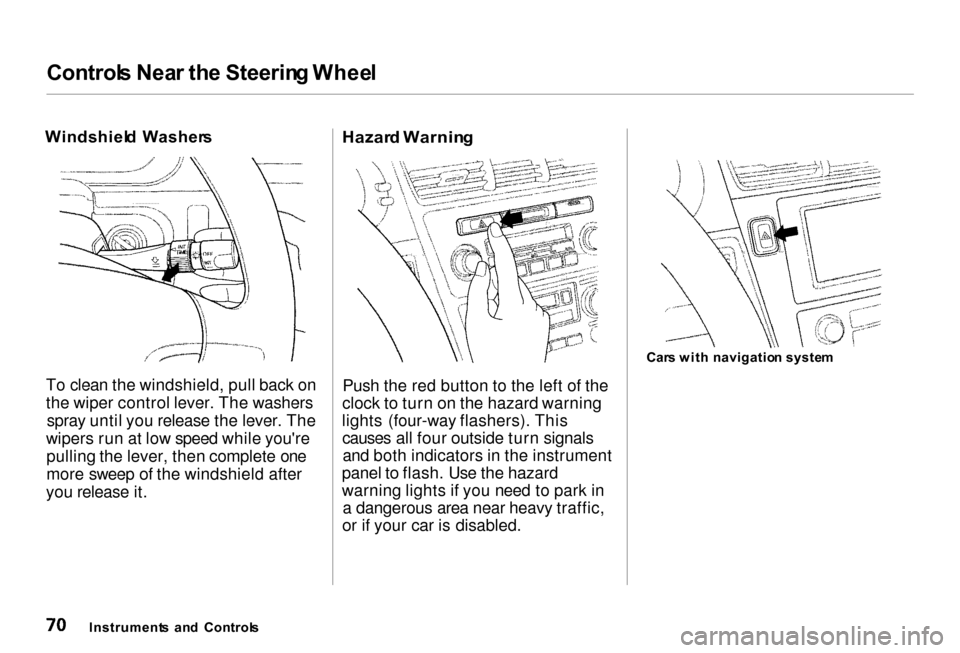
Control
s Nea r th e Steerin g Whee l
Windshiel d Washer s
To clean the windshield, pull back on
the wiper control lever. The washers spray until you release the lever. The
wipers run at low speed while you're pulling the lever, then complete one
more sweep of the windshield after
you release it.
Hazar
d Warnin g
Push the red button to the left of the
clock to turn on the hazard warning
lights (four-way flashers). This causes all four outside turn signalsand both indicators in the instrument
panel to flash. Use the hazard
warning lights if you need to park in a dangerous area near heavy traffic,
or if your car is disabled. Car
s wit h navigatio n syste m
Instrument s an d Control s
Page 74 of 330

Control
s Nea r th e Steerin g Whee l
Rea r Windo w Defogge r
The rear window defogger will clear fog, frost, and thin ice from the
window. Push the defogger button to turn it on and off. The light in the
button lights to show the defogger is
on. If you do not turn it off, the
defogger will shut itself off after
about 25 minutes. It also shuts off
when you turn off the ignition. You have to turn it on again when you
restart the car.
Car
s wit h navigatio n syste m
Make sure the rear window is clear and you have good visibility before
starting to drive.
The defogger and antenna wires on the inside of the rear window can beaccidentally damaged. When
cleaning the glass, always wipe side
to side. Steerin
g Whee l Adjustment s
See page 17 for important safety
information about how to properly
position the steering wheel
Your Acura's steering wheel is electrically-adjustable for angle and
distance. The adjustment switch is
on the left side of the steering
column. Always adjust the steering
wheel before you begin driving.
CONTINUED
Instrument s an d Control s
Adjusting the steering wheel
position while driving may
cause you to lose control of the
car and be seriously injured in a
crash.
Adjust the steering wheel only
when the car is stopped.
Page 75 of 330
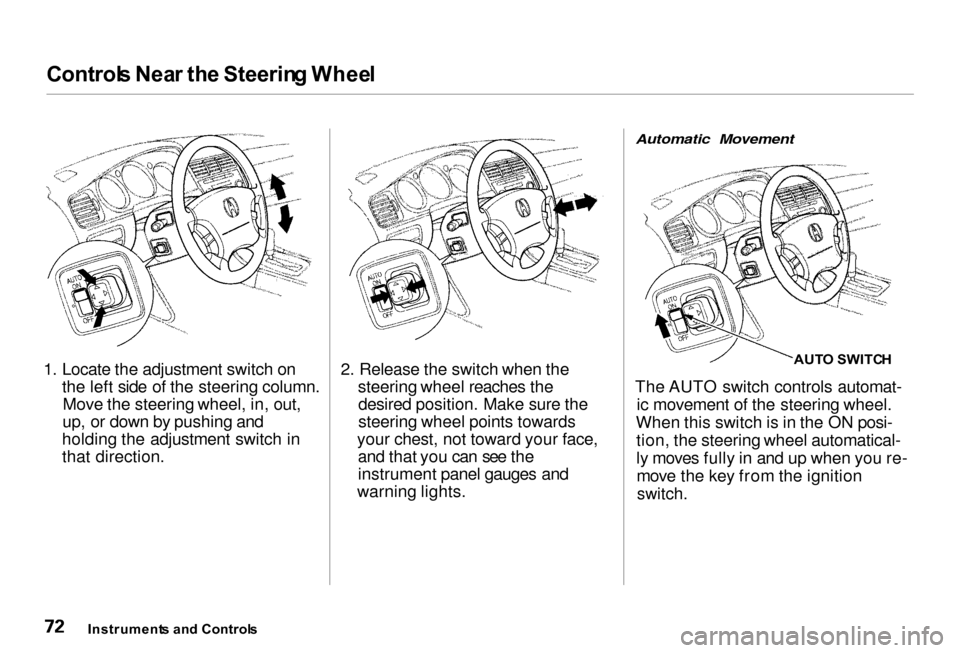
Control
s Nea r th e Steerin g Whee l
1. Locate the adjustment switch on the left side of the steering column.Move the steering wheel, in, out,
up, or down by pushing and
holding the adjustment switch in
that direction. 2. Release the switch when the
steering wheel reaches thedesired position. Make sure the
steering wheel points towards
your chest, not toward your face, and that you can see the
instrument panel gauges and
warning lights.
Automatic Movement
AUTO SWITC H
The AUTO switch controls automat- ic movement of the steering wheel.
When this switch is in the ON posi- tion, the steering wheel automatical-
ly moves fully in and up when you re-move the key from the ignition
switch.
Instrument s an d Control s
Page 76 of 330

Control
s Nea r th e Steerin g Wheel , Steerin g Whee l Control s
The steering wheel then returns to its original position when you insert
the key back in the ignition switch.
Steering wheel movement is also
controlled by the Driving Position
Memory System (see page 100). Cruis
e Contro l
Cruise control allows you to maintain
a set speed above 25 mph (40 km/h)
without keeping your foot on the accelerator pedal. It should be used
for cruising on straight, open highways. It is not recommended for
conditions such as city driving,
winding roads, slippery roads, heavy rain, or bad weather. You should
have full control of the car under
those conditions. Using the Cruise Control
CRUIS E CONTRO L MASTE R SWITC H
1. Push in the Cruise Control Master Switch to the left of the steering
column. The indicator in theswitch will light.
2. Accelerate to the desired cruising speed above 25 mph (40 km/h).
CONTINUED
Instrument s an d Control s
Improper use of the cruise
control can lead to a crash.
Use the cruise control only
when traveling on open highways in good weather.